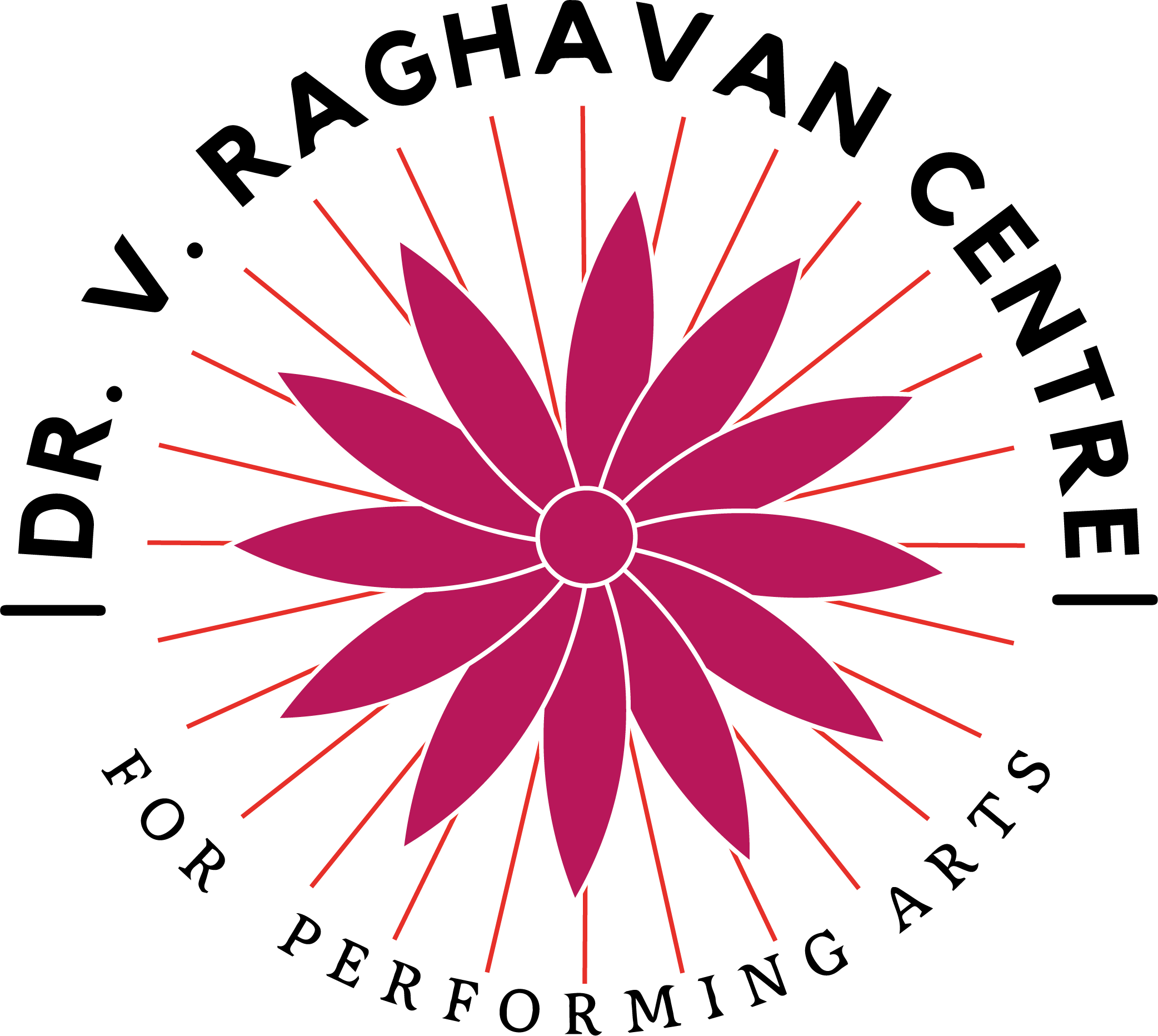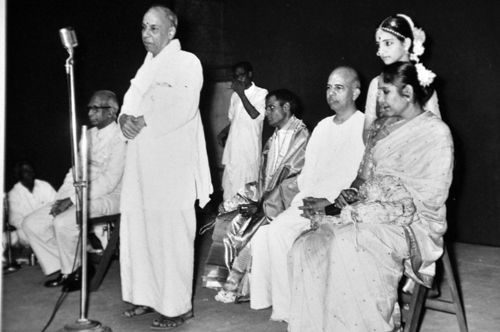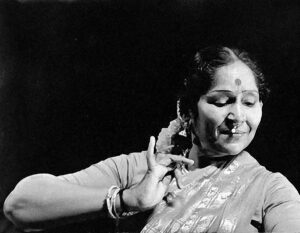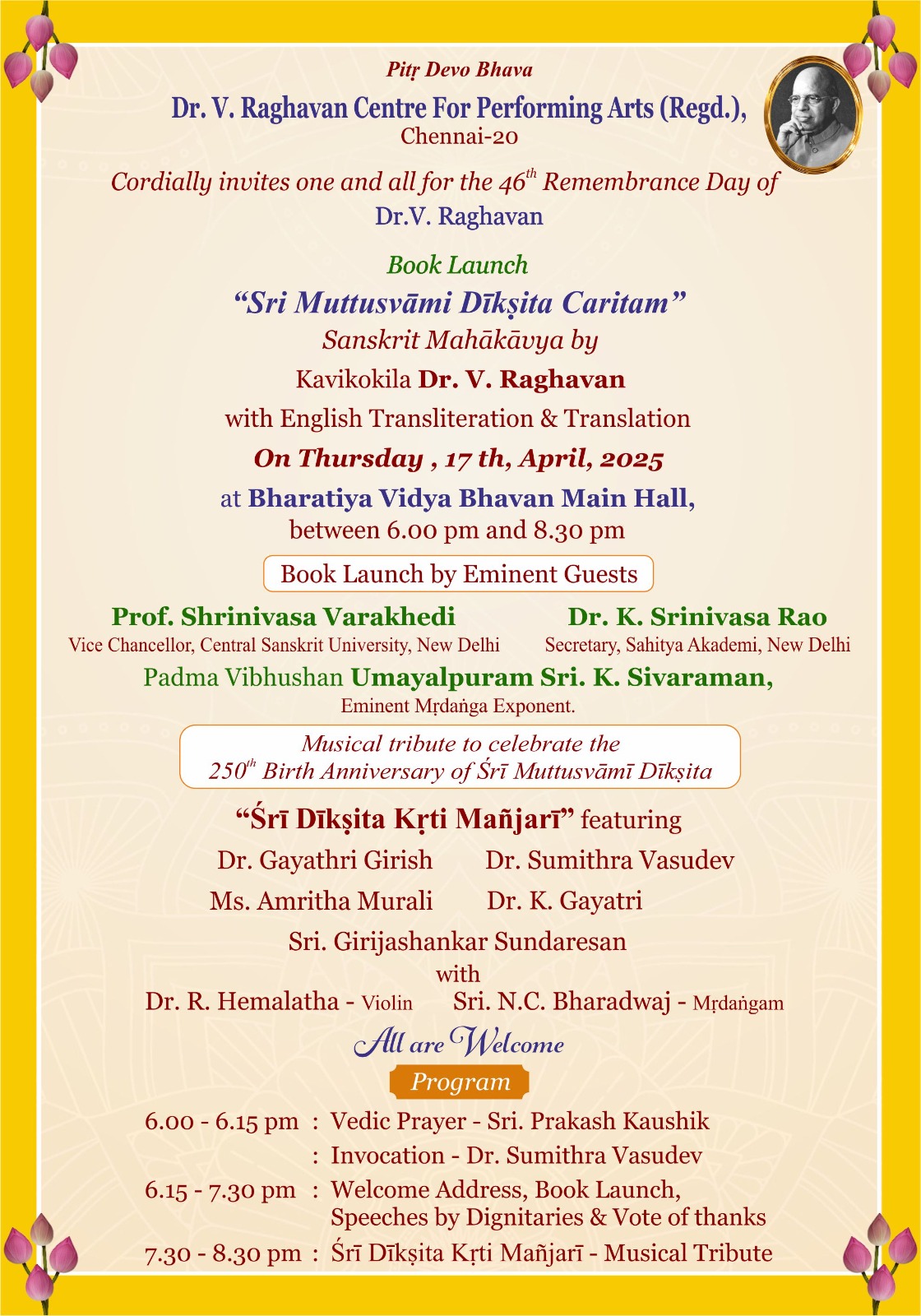Dr.V.Raghavan’s reach and research on the varied dance forms and traditions which got enlarged over decades of his brilliant academic contributions, were driven by two major influences: the first being the great aesthetic appeal of grand performances of the dance par-excellence of South India-Bhartanatyam as seen by him right from his young age both in his native village and around but also those at prominent cultural venues of the then Madras Presidency; the second being his close association with renowned practitioners, scholars, and other cultural personalities in the fields of Music and Dance. These influences accelerated his deep interest to involve himself further into the realms of the text and practice of the different dance-forms. As in the other fields of his study, Raghavan wrote extensively in this field too; his articles, reviews, and expositions covered various aspects of dance. In his younger days he wrote reviews on forms of dance, Harikatha and Carnatic Music under the pseudonym “Bhavuka” or “Bhava Raga Tala” for well-known journals of those times like Triveni and Sound & Shadow.
Among the dance traditions, although he chose to write more on Bharatanatyam, he also dealt in detail about dance-theatres like the Bhagavatamela, Yakshagana, Kathakali, Veethi Bhagavatam, and the last of the remaining Sanskrit dramatic tradition of Kerala, the Kootiyattam. The last mentioned Sanskrit theatre was brought out by him for the first time from the temple precincts to the urban platform under the auspices of his own organisation, the Samskrita Ranga in 1962. Other dance-forms like the Kandyan Dance, the Dance and Drama of Sri Lanka, South East Asia, the Western interpretation of Dance, and his own Dance and Music experiences in the west were also featured in his writings.
Of Raghavan’s many extensive writings on theoretical and technical aspects of dance, both in English and Tamil, several have been compiled by the Dr.V. Raghavan Centre for Performing Arts, Chennai. Of particular interest is the “Splendours of Indian Dance”, in English, which is the most sought-after collection, covering a wide range of his articles on the subject, “Natya Dharmi and Loka Dharmi”, Uparupaka-s and Nritya Prabandha-s. In articles on Bharatanatyam and its controversy in Sadir-Nautch, Raghavan gave deep insight into the scene of the art-form in the mid-1930s and his own assessment of the issue and its surroundings. These articles vibrate and reveal the young energy of Raghavan, who as a keen and ardent admirer of Bharatanatyam was carefully observing, while extending and supporting in a major way, the traditional performers of the art, many of whom were known to him, during the period of transition of the art-form from the traditional spaces to the proscenium stage, and then in the period of Renaissance of the same.
Raghavan’s detailed paper on Bhartanatyam, which he presented at the very first Dance seminar at the Central Sangeet Natak Akademi, New Delhi, in 1958, covered both the textual and practical aspects of the art. By then his two decades of association with the legendary Bharatanatyam exponent Smt. T. Balasaraswati, whose recital he had reviewed even as early as in 1938 in the magazine Sound & Shadow, had resulted in Raghavan establishing a Bharatanatya school affiliated to the Madras Music Academy in 1953. He enrolled his elder daughter Priyamvada, who had already started taking dance lessons in 1951, from T. Balasaraswati at this school. Both Balasaraswati and Priyamvada along with Raghavan, were part of this historic seminar which received great attention from connoisseurs.
Raghavan’s major works on Dance and Drama, such as the Nritta Ratnavali of Jayasenapati of 1254 A.D. and Srngara Manjari of Saint Akbar Shah of the 17th century, are unique works of timeless value for researchers. In addition to editing these works, for the Nrittaratnavali, he has given extensive supplemental information in an extensive introduction and footnotes. The introduction alone is 164 pages long, that deal with the author of the text, Sanskrit literature and dance in Andhra; it also discusses the edited text in relation to other texts, the contribution of two predecessors, Kirtidhara and Bhatta Tandu, the first ever critical examination at length of the Karana-s in different texts and sculptures, Desi dance and in particular, Desi-Lasya, Desi-Lasyanga-s, popular dance-Forms, Orchestra, Training, Theatre and Performance form part of this unique account. Raghavan has also provided comparative notes, concordance with Natya Sastra, Abhinavabharati and other works. His in-depth analysis of this text, with parallel analysis of the Desi element of dance by earlier writers like Matanga in his Brhaddesi and Sarngadeva in his Sangita Ratnakara is unique and invaluable account.
The classification of the Nayika-Nayaka concept is handled with such expertise by V. Raghavan in Srngaramanjari that it opens up a whole treasure of information on the entire theme. The classification of the heroines and heroes, their types as dealt in Sanskrit Poetics, Dramaturgy and Erotics, have been discussed at length, drawing material from printed and unprinted literature; Raghavan gives references regarding the differences of the different types as found in various Alankara works. His unique thought process that deals with the subject in myriad approaches like providing a table of the Nayikas identifying each of them in the verses of Amrusataka, other works dealing with the same subject as well as views of certain other writers.
Raghavan’s discovery of the 17th century Sanskrit manuscript of Srngaramanjari of Saint Akbar Shah, which was almost forgotten, is a proof of his tireless zeal and efforts in bringing for the first time to the world at large, the rhetoric of love through two manuscripts that he found in the course of his search. His presentation of the rejected readings from the two manuscripts, whether corrupt or not, in the footnotes and his reconstruction of the text or suggested recommendations wherever needed, provide short explanatory notes in Sanskrit and English on the meanings of some passages, Srngaramanjari, for a better understanding of the text. Raghavan has provided an exclusive analysis of classifications of Nayika-Nayaka that are unique to the Srngaramanjari. These cover the sub-varieties of Nayikas and their state of suffering, the functions of Duti-s and Sakhi-s and their male counterparts with their own classifications cited from Natya Sastra, Srngaratilaka, Srngara Prakasa, etc. Different Sanskrit Plays and Poems are taken for detailed analysis by Raghavan in his long introduction to enable practitioners to connect theory and practice aptly. Thus Raghavan’s research findings of these treatises are of immense value to all the researchers of the future, particularly in English medium researchers by giving them a well balanced understanding of these ancient treatises. The above studies are as much a contribution to Dance as to Poetics or Alankara Sastra.
Raghavan’s involvement in the practical side of Bharatanatyam was seen in the way he nourished and cherished several traditional practitioners of this dance-form, each of whom excelled in their own Sampradaya-s and were vital to the different oral traditions handed down through their generations. T. Balasaraswati, the legendary Bharatanatyam exponent and the grand daughter to the legendary Vina exponent Dhanammal was a long-time close associate of Raghavan. The two daughters of Raghavan, Priyamvada and Nandini, were trained by Balasaraswati since their childhood and became the senior most torch-bearers of this illustrious tradition, with their own meritorious performances and achievements in the field. Raghavan’s admiration for Balasaraswati’s art began early in his life; in 1933 he even wrote a critique of young Balasaraswati’s performance under the pseudonym Bhavuka in the Sound & Shadow magazine.
Raghavan penned compositions for dance in Sanskrit, specifically for the performances of Balasaraswati and his daughters, Priyamvada and Nandini. A Sabda on Goddess Kalpakamba, the beloved consort of Lord Kapalisvara enshrined in the temple at Mylapore, Madras and a song composed on Devi Bhartamata at the suggestion of President Dr. S. Radhakrishnan, fetched wide appreciation at several venues and continues to do so. Another Sabda, composed on the occasion of the Bicentenary of Sri Muttusvami Diksita and Slokas on Siva Nataraja and Dasavatara became part of regular performance repertoire of this style.
Raghavan gave many talks in the All India Radio on different aspects of Bharatanatyam as well as dance as ritual. These were published in a book titled “Nattiyakkalai” (the Art of Dance) which was released by Smt. Kamaladevi Chattopadhyaya, the then Chairman of the Sangeet Natak Akademi in 1974 during the annual Music festival of the Music Academy, Madras in its morning conference sessions. The other major contribution of Raghavan was to write a technical book on the art of Bharatanatyam in 1956. He had been writing on this subject from 1951, starting with its ancient past and evolution. With the assistance of Balasaraswati and the legendary dance master K. Ganesan, he planned the text on the performance format of the renowned and well designed style of the illustrious Kandappa, the mentor of Balasaraswati and father of K. Ganesan. The book was a fine piece of work in that it covered both the aspects of Sastra and Prayoga of the art-form blended beautifully; it was a first time publication in that field in those times and valued as a useful guide to the society at large that was then recognizing the greater aesthetic beauty and divinity of Bharatanatyam.
In the book, Raghavan included photographs of all the basic exercises of the style by making his elder daughter Priyamvada demonstrate them step by step, while excerpts of the repertoire, both technical and interpretative stances were done by Balasaraswati herself. The book was a typical study book not only meant for students of the art-form but also for all new enthusiasts and connoisseurs in the cultural scene. Thus it became a huge hit at that time mainly because it was an early, bold attempt, coming from two experts in the scene, Raghavan an authority in the Sastra and Balasaraswati in the Prayoga. Besides, there was hardly any effort like this from the traditional practitioners of the art-form during those years of its major resurgence.
The above book titled “Bharatanatyam” authenticated the style of T. Balasaraswati as containing all the essential material crucial for a proper, firm, excellent tradition. The Southern Languages Book Trust was assigned to printing 5000 copies of the book in all the four southern regional languages, namely in Tamil, Telegu, Malayalam and Kannada. The first print created history by all the 5000 copies being sold in record time.
Apart from supporting Balasaraswati’s artistic career at various stages of her life and establishing for her a dance institution affiliated with the Music Academy, Madras, Raghavan, in the capacity as the Academy’s long-time Secretary, took a keen interest in nurturing several other traditional practitioners and dance masters. As one of the founding member of the Central Sangeet Natak Akademi and with his association to several cultural missions in India and abroad, he found opportunities and venues for artists like Balasaraswati and brought them Recognition and Awards from National bodies.
As Secretary of the Music Academy, his contribution to dance was phenomenal, not only through his writings and organizing of events, but also through wide networking of artists and art-form of various Indian regions and other nations, and presenting them in performance as well as in lecture – demonstrations, by giving them opportunities to present various topics in their chosen fields. The Academy’s journal that he edited, carried sumptuous information on all these art-forms and their variations, with reference to their text and practice. Simultaneously, he reported on these in daily columns of The Hindu to create a wider awareness and appreciation. Raghavan was also a strong proponent in bringing to the city of Madras several of the greats from different artistic streams of our rich traditions much to the joy of the lay and the learned alike.
By Nandini Ramani




